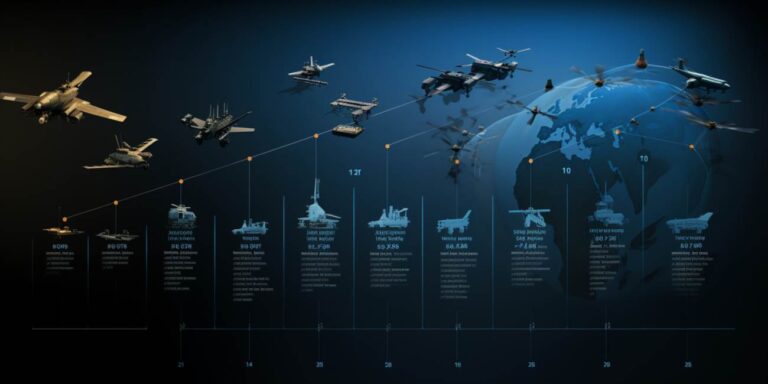In the early 1900s, as military aviation took its initial steps, nations recognized the vulnerability of their territories to aerial attacks. The first practical attempts to counter this threat involved adapting existing artillery for anti-aircraft purposes. One of the pioneering developments occurred during World War I, where various nations experimented with modifying artillery pieces for anti-aircraft use.
The pivotal moment in the history of anti-aircraft guns came in 1915, when the French Army introduced the concept of dedicated anti-aircraft artillery. These early anti-aircraft guns were often heavy, cumbersome, and lacked the precision needed to effectively target fast-moving aircraft. However, they marked a crucial shift in military strategy, acknowledging the necessity of specialized weapons for aerial defense.
The subsequent years witnessed significant advancements in anti-aircraft technology. Innovations in fire control systems and the introduction of specialized anti-aircraft gun designs improved accuracy and targeting capabilities. By the time World War II erupted, anti-aircraft guns had become integral components of military arsenals worldwide.
The evolution of anti-aircraft guns also saw the development of automatic weapons, such as the famous German Flak 88. These guns were equipped with rapid-fire capabilities, enhancing their effectiveness against agile and high-speed aircraft. The shift towards lighter, more mobile anti-aircraft guns further highlighted the continuous refinement of these defensive systems.
During the Cold War era, anti-aircraft technology continued to progress, with the integration of radar systems and guided missiles. This marked a departure from traditional gun-based defenses and showcased the adaptation of technology to meet the challenges posed by evolving air threats.
While anti-aircraft guns have undergone significant transformations since their inception, their fundamental purpose remains unchanged: to protect against aerial threats. The continuous advancements in technology and the integration of sophisticated systems have further solidified the role of anti-aircraft guns in modern military strategies.
Anti aircraft guns in world war i: defending against early aircraft
In the tumultuous theater of World War I, the emergence of aircraft as a weapon presented a novel challenge to military forces. The advent of aviation brought about the need for anti-aircraft defenses to counter these aerial threats. One of the primary solutions devised was the deployment of anti-aircraft guns, a pivotal development in early air defense strategies.
These guns, often mounted on both stationary positions and mobile platforms, played a crucial role in protecting ground targets from enemy aircraft. The rapid advancements in aviation technology during this era spurred the evolution of anti-aircraft weaponry in tandem.
The primary objective of anti-aircraft guns was to deter or neutralize enemy planes, primarily bombers, aiming to inflict damage on strategic locations, troops, or infrastructure. The guns’ effectiveness lay in their ability to project projectiles at the high altitudes where aircraft operated.
| Type of Anti-Aircraft Guns | Key Features |
|---|---|
| Heavy Caliber Guns | These weapons boasted larger projectiles and were typically used for long-range attacks against high-altitude targets. |
| Rapid-Fire Guns | Characterized by their quick firing capabilities, these guns were effective against faster-moving aircraft at closer ranges. |
Strategically positioning these anti-aircraft batteries around vital installations, such as munition depots, airfields, and industrial centers, became a standard practice. This defensive measure aimed to create a web of protection against aerial assaults.
However, the effectiveness of anti-aircraft guns was not without challenges. The speed and maneuverability of aircraft often rendered hitting targets challenging, requiring constant adjustments in tactics and gunnery techniques. The introduction of measures like predictive firing and advanced aiming mechanisms helped improve accuracy.
The significance of anti-aircraft guns in World War I cannot be overstated. They marked a critical shift in military strategy, highlighting the necessity for specialized defenses against the aerial threat posed by evolving aviation technology. Their legacy continued to shape the development of air defense systems in subsequent conflicts, setting the stage for modern anti-aircraft capabilities.
Radar guided anti aircraft systems: revolutionizing aerial threats detection
The evolution of radar technology has marked a paradigm shift in the realm of aerial threats detection. As we delve into the intricacies of radar-guided anti-aircraft systems, the synergy between radar, guidance, detection, and technology becomes the linchpin of modern defense mechanisms.
At the core of this revolution is the radar system, a ubiquitous sentinel that scans the skies with unparalleled precision. Unlike its predecessors, contemporary radar systems leverage advanced signal processing algorithms, enhancing their ability to detect and track potential threats. The days of mere point-targeting are long gone; today’s radar systems boast multifunctionality, capable of concurrently monitoring multiple targets across vast expanses.
The marriage of radar and guidance systems births a formidable duo. Guided by intricate algorithms, these anti-aircraft systems can not only identify hostile aircraft but also predict their trajectories. This predictive prowess is a game-changer, allowing rapid and precise deployment of countermeasures. The era of reactive defense has given way to proactive interception, where radar-guided systems preemptively neutralize threats before they breach secure airspace.
Within the tapestry of detection capabilities, radar emerges as the linchpin. Its ability to penetrate darkness, adverse weather conditions, and even certain stealth technologies renders it indispensable. The cloak of invisibility once associated with certain aircraft is unravelled by the unyielding gaze of modern radar systems. Stealth may afford a level of cover, but the radar’s discerning eye pierces through these layers, ensuring a comprehensive and unwavering surveillance net.
Underpinning these advancements is the bedrock of technology. The relentless march of innovation has equipped radar-guided anti-aircraft systems with not just enhanced sensitivity but also adaptability. Machine learning algorithms, integrated into the fabric of these systems, endow them with the ability to learn, evolve, and anticipate emerging threat patterns. The fusion of cutting-edge technology with radar capabilities heralds an era where defense systems are not static entities but dynamic, learning guardians of the skies.
As we navigate through this landscape of radar-infused defense, a key aspect is the seamless coordination facilitated by these systems. In a synchronized ballet of radar-guided precision, multiple defense units communicate, share data, and collectively form an impenetrable shield. The orchestration of radar, guidance, detection, and technology harmonizes into a symphony of security, where vulnerabilities are minimized, and threats swiftly neutralized.
Missile systems take over: the cold war and modern anti aircraft defense
The cold war era marked a significant turning point in the evolution of missile systems, propelling the arms race into new dimensions. As geopolitical tensions heightened, nations sought more sophisticated weaponry, with an emphasis on modern technologies to gain a strategic edge. The development of missiles became a cornerstone in military arsenals, reshaping the landscape of global defense.
During the cold war, the race for missile supremacy was dominated by two superpowers—the United States and the Soviet Union. Each side strived to outpace the other in creating modern and highly effective missile systems. The threat of mutually assured destruction loomed large, pushing both nations to innovate in anti-aircraft defense strategies to counter potential missile attacks.
One of the key developments during this period was the emergence of intercontinental ballistic missiles (ICBMs). These missiles had the capability to travel vast distances at incredible speeds, making traditional defense mechanisms obsolete. The emphasis shifted from traditional anti-aircraft guns to advanced missile defense systems designed to intercept incoming threats in the upper atmosphere.
The cold war legacy echoes in the present-day dynamics of military technology. The advancements made during that era laid the foundation for modern missile systems. Today, nations invest heavily in cutting-edge missile technologies, with an emphasis on precision, speed, and evasive maneuvers to render anti-aircraft defense systems less effective.
The evolution of missiles from the cold war era to the present reflects a constant game of one-upmanship. From the strategic necessity of ICBMs to the development of cruise missiles with pinpoint accuracy, the pursuit of modern weaponry has redefined the concept of warfare. In response, anti-aircraft defense has undergone continuous adaptation, employing radar systems, surface-to-air missiles, and integrated defense networks to counter the ever-evolving missile threats.
A crucial aspect of modern anti-aircraft defense is the integration of multi-layered systems. This involves a combination of short-range and long-range missile interceptors, backed by radar and satellite surveillance. The goal is to create a comprehensive shield against missiles of varying capabilities and trajectories, making the defense architecture more versatile and effective.
As we delve into the intricacies of missile systems, it becomes evident that the cold war era not only set the stage for modern advancements but also established the importance of strategic foresight in anti-aircraft defense. The ongoing pursuit of technological superiority in the realm of missiles and anti-aircraft defense underscores the ever-present need for nations to stay ahead in this high-stakes game of deterrence.
See also:
- What is military aircraft: their role and capabilities explained
- How many ships and aircraft were used by japan in the attack on pearl harbor
- Embraer emb 314 super tucano – the brazilian turboprop light attack aircraft
- What was the first mig aircraft: a history of soviet fighter jets
- What aircraft can fly the highest: exploring the limits of flight





